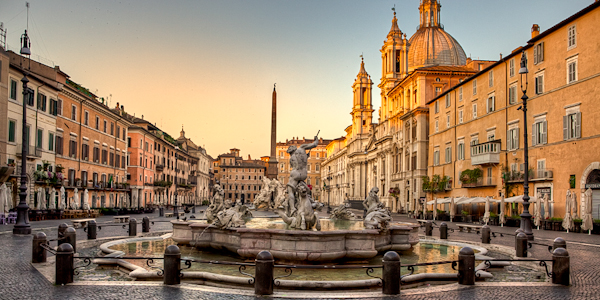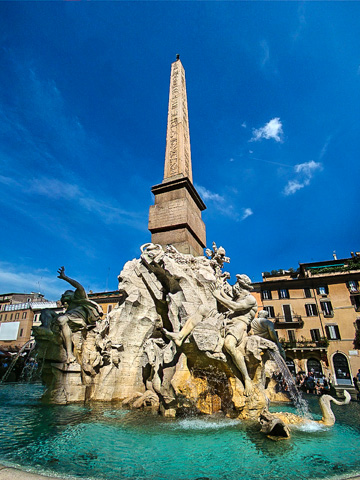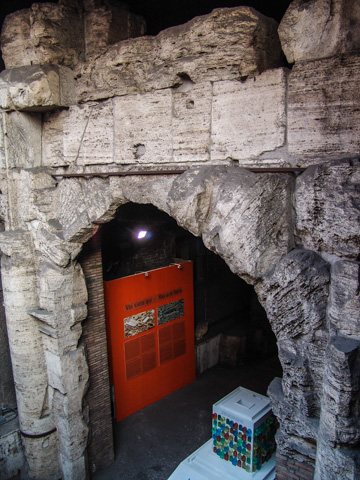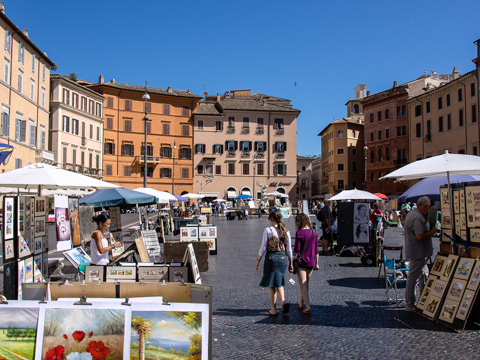

Closed to traffic, studded with fountains, lined with cafes, and filled with tourists, street performers, artists, kids playing soccer, and amorous Roman couples, Piazza Navona is one of Rome’s archetypal open spaces. It’s also one of the best places to kick back and relax in the heart of the city.
The piazza owes its long, skinny, round-ended shape to the AD 86 Stadium of Domitian (see sidebar below), which once held chariot races to entertain up to 30,000 screaming fans in the bleachers and even threw mock sea battles with scaled-down ships (how they managed to fill the space with water, I've no idea).
These days, the oblong square still drams the crowds with a play of water in the form of a trio of statue-studded fountains. The Fountain of the Moor on the piazza's south end was designed by Giacomo della Porta (1576), the Fountain of the Neptune at the north end by Antonio della Bitta and Gregorio Zappalà (1878), and, most famously, the soaring Fountain of Four Rivers in the center by Gianlorenzo Bernini (1651).
This Fontana delle Quattro Fiumi is a roiling masterpiece of rearing mer-horses, sea serpents, and muscle-bound figures topped by an obelisk, which, in a feet of engineering, is supported by corner buttressing so that the space directly beneath it could be hollowed out.
(Interesting aside: though the obelisk is, as are most in Rome, cut from Egyptian marble, it does not date from the age of the pharaohs. The Emperor Domitian himself had the obelisk crafted and shipped from Egypt—by then, part of the Roman Empire—and covered with "hieroglyphics" naming the emperors Vespasian, Titus, and Domitian.)
The giant figures at the fountain's four corners represent the world's four great rivers (or at least those known in the 1650s): the Danube (Europe), the bearded Ganges (Asia), the bald Plate (Americas), and the Nile (Africa, shrouding his head since the source of the Nile was unknown at the time).

Echoes of Antiquity
Today, the remains of the Stadium of Domitian lie mostly unexcavated underneath Piazza Navona's palaces, but you can see one travertine entrance arch from the stadium's north curve buried under a modern bank building on Piazza di Tor Sanguigna, just outside the north end of the piazza (peer over the railing and down; pictured below). The ancient stadium also survives in the piazza's very name. In ancient time, the stadium was home to the popular "Agoni Capitolini" athletic games. By the Middle Ages, Romans were still calling this space "Campus Agonis," which became agone, which the Roman accent eventually rendered n'agona, and finally navona.

The church itself is lovely inside—though rather plain (compared to most art-stuffed Roman churches), but its titular saint was not.
Sant'Agnese is the patron saint of girls and virgins in general. She got the gig in the worst possible way: the 13-year-old girl was forcibly engaged to marry a Roman in AD 304, but since she was Christian and he was pagan, she refused. She was summarily sentenced to die, but the problem was that, under Roman law, you couldn't kill a virgin.
Their solution? De-virginize her.
Roman soldiers dragged her to this site, which at the time housed a popular brothel, and stripped her naked. But St. Agnes had a secret weapon: prayer. Her hair grew, Rapunzel-style, to cover up her nakedness. Frustrated, the soldiers used their swords to hack off her hair, but through divine intervention every letch who looked at her was suddenly struck blind.
Angered, they next tried burning her at the stake, but she continued to pray and the wood refused to catch fire. The soldiers couldn't take it anymore and, virgin or not, they resorted to simpler measures: they struck of her head. That worked—but it also made a martyr and a saint out of her, and she has looked after he fellow little girls and virgins every since.
Incidentally, the church now hosts regular evening concerts; you can see the schedule and book tickets for performances here:

Piazza Navona also served as a marketplace from 1477 to 1869, and for ages it has hosted a Christmastime fair selling traditional presepio (nativity, or Christmas crèche) figurines and statues along with toys and dolls of the Christmas Witch La Befana, who traditionally brings Italian children presents on January 6 (though with Europe's general Americanization, Santa Claus has been making inroads in the Italian kiddie consciousness and most Roman tykes now get gifts on December 25 from Santa and again on January 6 from the Befana. » more).
Pony up the couple of Euro it'll cost for an overpriced cappuccino—or, if you're at Tre Scalini, one of their famous tartufi (see the "Gelato Gobstoppers" box to the right)—but that's a paltry admission price for watching the parade of Roman life that swirls and tumbles past.
Gelato Gobstoppers
The elegant Piazza Navona cafe called Tre Scalini is world-famous for its tartufo, the gobstopper of the ice cream world. This delectable frozen confection is a ball studded with chocolate chunks over a layer chocolate gelato over a layer of vanilla gelato over a fudge core with a candied cherry at the center. It's worth every Euro (and every calorie).
Gaggles of tourists snap pictures of street performers busking for change, or haggle with the artists hawking their watercolors on rickety display stands and African immigrants selling decorative fezzes and skullcaps from sheets they can gather up quickly at any sign of a policeman.
Lovers smooch on the marble benches surrounding those splashing Bernini fountains, oblivious to the kids kicking soccer balls over their heads. Snappy waiters thread amongst the tables ranked before overpriced cafes carrying trays of fresh cappuccini or, as the afternoon wears on, virulently red Campari-sodas. On rare occasions, worshippers file in and out of the church.
Of course, you could sit for free on a bench or on the steps to Sant'Agnese in Agone church, but it's worth even the jacked-up prices to snag a good café table and while away an afternoon.
Piazza Navona
Daily
Free
Bus: 30, 70, 81, 87, 130F, 186, 492, 628, 116, 116T, C3, N6, N7
Planning your day: Expect to spend at least 30–45 minutes wandering around the square, soaking in its sights, fountains, and carnival of life. My advice: pull up a cafe table and relax for an hour or two. » Rome itineraries
Take a guided tour of Piazza Navona with one of our partners:
Share this page
Search ReidsItaly.com
Piazza Navona
Daily
Free
Bus: 30, 70, 81, 87, 130F, 186, 492, 628, 116, 116T, C3, N6, N7